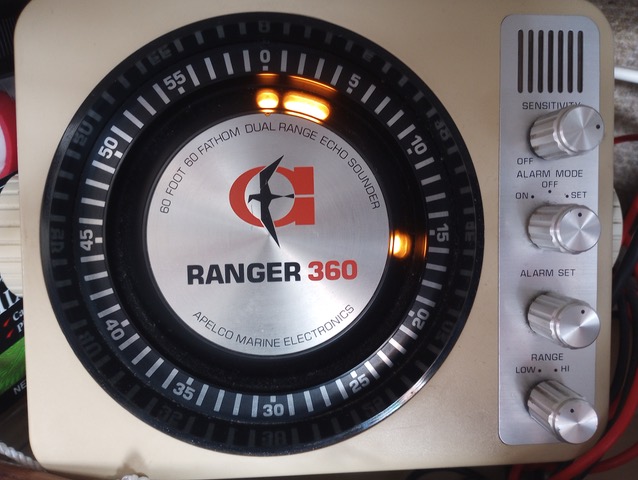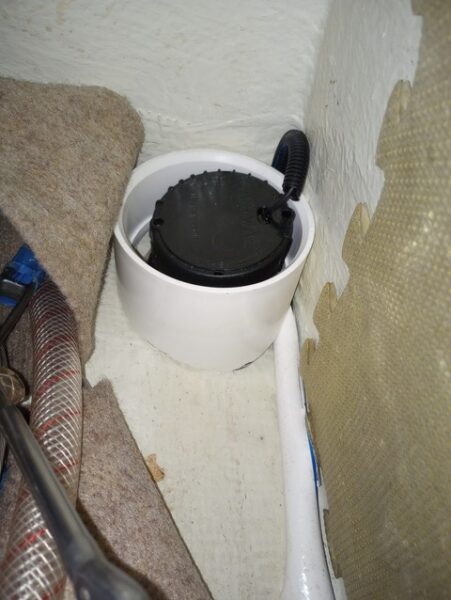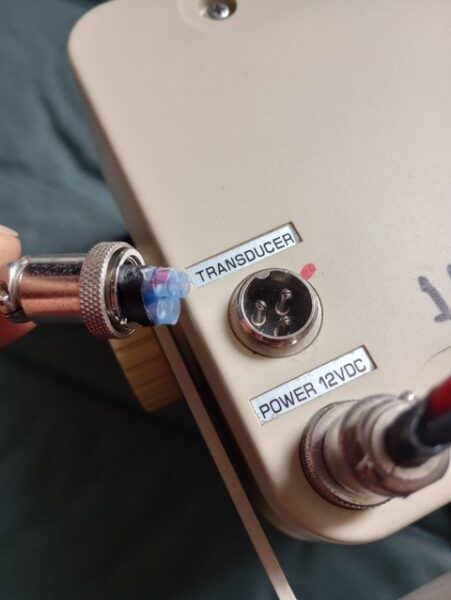
The Resourceful Sailor Revives an Apelco Ranger 360 Echo Sounder
Sampaguita, a 1985 Pacific Seacraft Flicka 20 sailboat, came with an Apelco Ranger 360 Echo Sounder when The Resourceful Sailor purchased her in 2013 in Seattle. Likely an ’80s vintage, the sounder seemed to work, but understanding and trust were low, and the sounder was in a difficult-to-view place. There was an in-hull transducer adhered with silicone below the settee. With no hole to maintain, it was easy to ignore. A lead line, good charts and guidebooks, and extra caution were sufficient for 10 years. But alas, with a recent refit of the energy system, and new sailing programs, a re-evaluation of sounder possibilities had begun.
Could the Ranger 360 be revived, or would a new system be the way? Simplicity and economy leaned toward revival, but some investigation was in order.

For a pre-internet electronic artifact, a web search came up with nothing. I called Raytheon (I mean Raymarine; no, I mean FLIR), and they had no idea either. “That was too many companies ago,” to paraphrase their response. It seemed that it used to work when I bought the boat, but at some point, it had begun only giving a blur of lights in the 0-5-feet range. I recognized this might have something to do with my messing around in the settee locker and disturbing the transducer over the years.
I suspected the silicone seal holding the transducer was compromised, so I reasoned that it would need at least removal and reinstallment regardless of revival or replacement. An in-hull transducer would not work with air between it and the hull, so I pried it out for inspection. The Raytheon transducer was a rectangle type with a blue face. The blue part had some corrosion, and the resultant expansion had cracked the outer plastic in one corner.
I decided to test the Ranger 360 by holding the transducer directly on the water surface over the side of Sampaguita. It immediately came alive with a reading of 19 feet in my slip. I checked with the lead line … 19 feet. Spot on. I double-checked and triple-checked.
Revival of the Ranger 360 was looking good, but a new transducer was in order. It seemed to work, but the corrosion and crack deemed it replaceable. Interest in drilling a hole in the hull was nil and would require a haulout. I would still use an in-hull transducer, whether a new sounder or a revival of the old. There were many doubters about this approach, including myself, so I needed some confidence that it would reliably shoot through the hull. For this, I used a bag of water. This method is how Airmar tells you to test their transducers when choosing an in-hull placement spot. It read 18 feet from under the settee, one foot below the waterline. Yes!

Echo sounding is a simple technology dating back over 100 years. The new units that send and interpret the sonar are fancier and more capable, but the concept is essentially the same. The Airmar P79 seemed an industry standard for in-hull transducers and had been around for decades. OK, but they were still $150 with far more wires than the three I needed for the 1985 Ranger 360. A search on eBay turned up a New Old Stock, three-wire Airmar P79 for $45, including shipping. That was more like it. The transducer had an early-2000s manufacture date, but was unboxed and new.
I followed the installation instructions that came with the new transducer. I found a more suitable and protected spot under the settee and adjusted the transducer and its separate base to the deadrise of the boat. I cleaned the hull well with alcohol but did not do any grinding. Using silicone, I adhered the bottom piece directly to the factory bilge coating at the best orientation. Once it was cured with a watertight seal, I filled it with water and locked the transducer into it. As directed, overfilling and a little cleanup from overflow were necessary to ensure no trapped air. They recommend mineral oil or antifreeze for the liquid, but I can attest that water works fine. Mineral oil doesn’t freeze and break the transducer. Water is easier to clean up.
Since the settee locker is important storage, I felt it necessary to devise a way to protect the transducer from shifting stores. While planning the transducer installation, I found a four-inch PVC pipe coupler that would fit over it. The bottom would need trimming to match the deadrise but would then surround the transducer wedged in the corner and take any pressure from neighboring items.
The transducer came with more than enough cable, but had no plug on the end. The old plug was an option, but its small size was difficult to work with and required a good solder job. This last part was an issue. My solder equipment and skill were subpar, and I have never been able to do a good soldering job. The Ranger 360 unit had a male three-prong plug. I wondered if a blue nylon butt connector might fit over each prong. Sure enough, it was snug on all three prongs. So I crimped connectors onto the transducer wires. “Trial and error” matched each wire to the correct prong, and voila! A working echo sounder.

On a 31-day trip around Vancouver Island, it proved itself in 29 anchorages. It helped suss them faster for depth and bottom type. The blur in the 0-5-feet range is still there. I suspect this is distortion caused by the keel and shooting through the hull, but I am not sure. Sampaguita has a draft of one meter, so she has no business in that depth of water anyway. The actual sounding measurement also varies between “crisp” and “blurry.” I understand this represents the bottom type. Crisper is typical of a hard or rockier seabed, and blurrier, a mud or weed bottom. Testing shows it consumes about 0.5 amps, with use a few minutes per day.
The Resourceful Sailor is still cautious, has a lead line, and uses charts and books, but he saw potential in a depthsounder if the value-to-production ratio made sense. Revival of the Ranger 360 Echo Sounder was not just an economical choice; the installation was entirely non-destructive. The unit is easy to read and analog, like Big Ben, and the reason for its size. It was also the one he owned already.
Remember, keep your solutions prudent and safe, and have a blast.

I have a Ferrograph Inshore “Flasher” type of echo sounder. Type M. It is 24volt dc operation and uses small thermionic valves”Tubes” it is in perfect condition but was not supplied with the transducer (143KHz) I would love a circuit diagram or a manual and schematic for this unit but can’t find one anywhere. Please can you help.